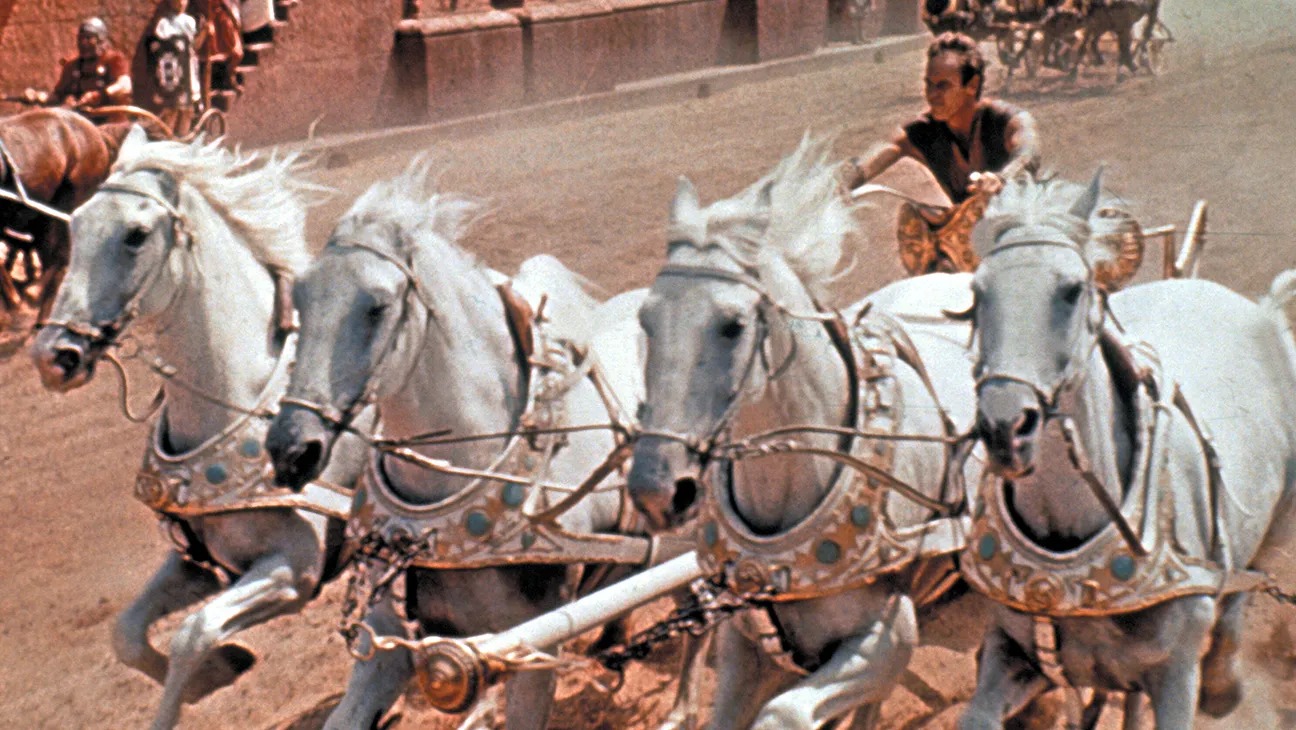Ben Hur (1959)

Ben-Hur (1959), directed by William Wyler and featuring a stellar cast including Charlton Heston, Stephen Boyd, Jack Hawkins, Hugh Griffith, and Haya Harareet, is a monumental epic film that has left an indelible mark on cinema history. This American historical epic, adapted from Lew Wallace’s 1880 novel of the same name, is renowned for its grand scale, compelling narrative, and its record-setting achievement of 11 Academy Awards, including Best Picture. This essay explores the film’s plot, themes, character development, direction, visual style, and its lasting impact on cinema.
Ben-Hur tells the story of Judah Ben-Hur (Charlton Heston), a Jewish prince in Jerusalem who is betrayed by his childhood friend, Messala (Stephen Boyd), a Roman officer. The film is set against the backdrop of the Roman Empire’s occupation of Judea and explores themes of revenge, redemption, and the transformative power of faith.
The plot begins with a dramatic and poignant betrayal. Judah Ben-Hur, a nobleman, is falsely accused of treason by Messala, resulting in his family being imprisoned, and his own life being ruined. Ben-Hur is sentenced to the galleys as a slave, and his journey from captivity to seeking revenge on Messala forms the core of the narrative.
A significant turning point in the story is Ben-Hur’s involvement in the iconic chariot race, which is one of the film’s most memorable and exhilarating sequences. This race not only serves as a dramatic climax but also represents Ben-Hur’s ultimate confrontation with Messala and his quest for justice.
The film’s overarching theme is redemption. Throughout the story, Ben-Hur’s quest for revenge evolves into a journey of spiritual awakening. His encounters with Jesus Christ, who appears in several key scenes, lead to a profound transformation, culminating in Ben-Hur’s realization of forgiveness and grace. This religious and moral dimension is central to the film’s narrative and emotional impact.
The characters in Ben-Hur are intricately developed, each contributing to the film’s epic scope and emotional depth:
Judah Ben-Hur: Charlton Heston’s portrayal of Judah Ben-Hur is both commanding and nuanced. Heston’s performance captures the character’s initial strength, vulnerability, and eventual spiritual awakening. His physicality and intensity make him an iconic figure in cinema history.
Messala: Stephen Boyd plays Messala, Ben-Hur’s friend-turned-foe, with a blend of charm and menace. Boyd’s performance adds depth to Messala’s character, illustrating his internal conflict and moral deterioration as he becomes a symbol of Roman oppression.
Esther: Haya Harareet portrays Esther, Ben-Hur’s love interest, with grace and depth. Her role as a supportive and loving figure contrasts with the film’s themes of vengeance and conflict, providing a sense of hope and stability.
Simonides and Sheik Ilderim: Jack Hawkins as Simonides, a loyal friend, and Hugh Griffith as Sheik Ilderim, a wealthy and influential ally, both provide strong supporting performances. Their characters play crucial roles in aiding Ben-Hur’s quest and adding layers to the narrative.
William Wyler’s direction of Ben-Hur is a masterclass in epic filmmaking. Wyler’s meticulous attention to detail and his ability to balance grand spectacle with intimate character moments contribute significantly to the film’s success. His direction of the chariot race sequence, in particular, is renowned for its technical prowess and cinematic impact.
The screenplay, adapted by Karl Tunberg and based on Lew Wallace’s novel, successfully captures the epic scope and emotional depth of the source material. The dialogue and plot structure blend historical drama with personal tragedy and redemption, creating a compelling and immersive experience.

The visual style of Ben-Hur is characterized by its grandeur and scale. The film’s use of large-scale sets, elaborate costumes, and sweeping cinematography creates a vivid and immersive portrayal of ancient Rome. The film’s production design, including the recreation of the Roman Colosseum and the depiction of the chariot race, is both historically accurate and visually stunning.
The chariot race, directed by Wyler and choreographed by stunt coordinator Yakima Canutt, is a highlight of the film’s visual and cinematic achievements. The sequence is renowned for its intensity, realism, and innovative use of practical effects, making it one of the most memorable scenes in film history.

The score for Ben-Hur, composed by Miklós Rózsa, is one of the film’s most celebrated aspects. Rózsa’s score, which won an Academy Award, enhances the film’s epic and emotional moments with its powerful and evocative themes. The music plays a crucial role in heightening the drama and grandeur of the narrative.
The sound design of Ben-Hur complements the visual spectacle, with a focus on creating a realistic and immersive auditory experience. The sound effects, particularly in the chariot race, contribute to the intensity and excitement of the action sequences.

Ben-Hur received widespread acclaim upon its release, praised for its epic scale, technical achievements, and powerful performances. The film’s record-setting 11 Academy Awards, including Best Picture, Best Director, and Best Actor for Charlton Heston, attest to its critical and commercial success.
The film’s legacy is significant, as it set a new standard for epic filmmaking and remains a touchstone in the genre. Its influence is evident in subsequent historical and biblical epics, and it continues to be celebrated for its ambitious scope and enduring impact.

In conclusion, Ben-Hur (1959) is a landmark film in the epic genre, celebrated for its grand scale, compelling storytelling, and technical achievements. Directed by William Wyler and featuring standout performances by Charlton Heston and Stephen Boyd, the film explores themes of revenge, redemption, and spiritual awakening against the backdrop of ancient Rome. Its record-setting success at the Academy Awards and its lasting impact on cinema underscore its status as a classic and a masterful example of epic filmmaking.
Suggested videos for you:
Suggested videos for you:
@lovrstify99 Avenger highlight
Suggested videos for you:
@licktowing11 Venom – The Birth of Carnage, A PlayStation Exclusive Extended Sneak Peek #movie #movieclip #highlight #venom #venom3 #actionmovie #tredingvideo











